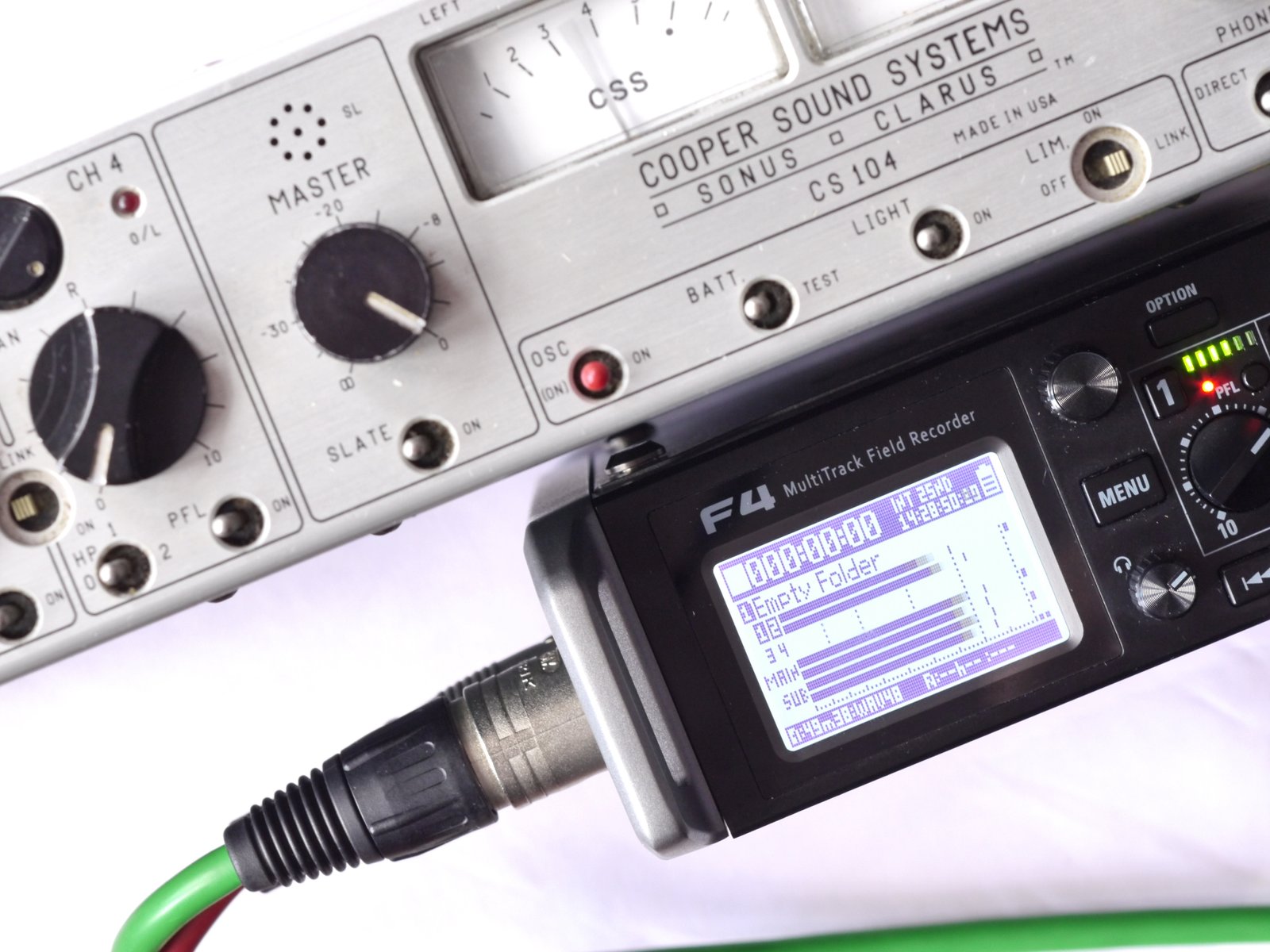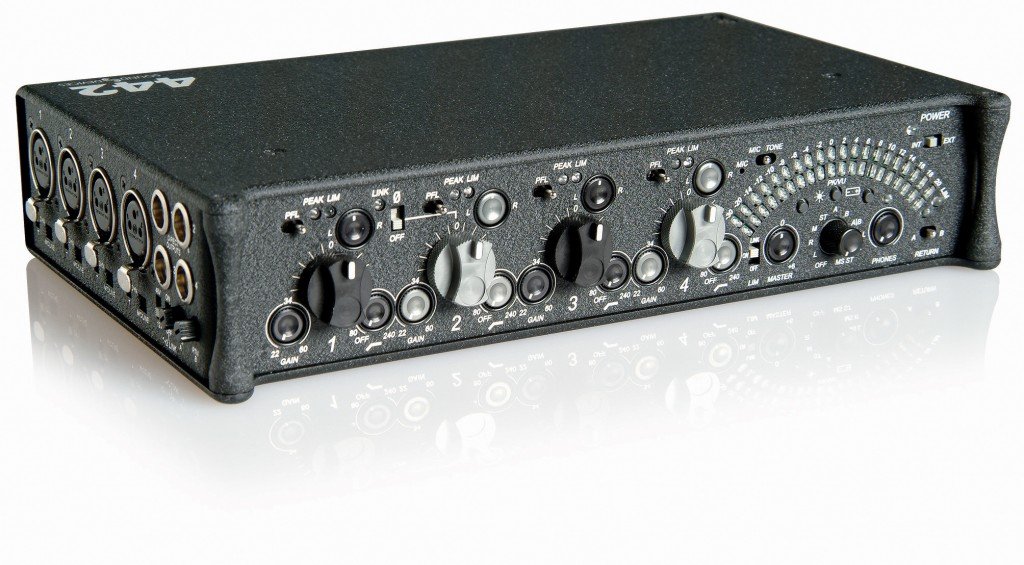One of the hardest things I had to do when leaving the BBC was hand back the Sound Devices 442/744 combination I knew and loved. I know some people preferred the headroom on the SQN and everyone loved the CooperSound but the 442 will always have a place in my heart. One day when I get the time I’ll do a comparative review. If you see one cheap that hasn’t been battered, buy it.
Stateside the professional portable mixer market has two notable landmarks. Shure offer the tried and tested FP 33 at under $2000, while at just about $4000 Cooper Sound have established an enviable reputation for hand built quality.
Sound Devices of Reedsburg Wisconsin have opted to go smack in the middle with their 442 $3000 four channel mixer offering a comprehensive specification and solid build quality. In Europe the situation is a little simpler but maybe even tougher to pitch at. Here if you aim for the niche from £2500 to £3000 you’ll be up against the ubiquitous SQN and it’s worthy challengers in the shape of mixers from Audio Developments and Wales’s very own Filmtech. With such stiff competition only a very good product has any chance anything merely competent will never persuade sound recordists who form the most intimate relationships with their gear to change to the new kid on the block.
Sound Devices began life about 4 years ago with first a single channel mic amp followed by a two channel field model and having established a good track record for build and sound the new 442 is their piece de resistance. When I first unpacked mine I was really impressed with the build quality and finish, a bit dubious about controls and layout and deeply skeptical about led based metering. The right hand side of the 442 is dominated by an arc of 40 tri-colour leds which are described as sunlight viewable. Mea culpa – these leds are sunlight viewable there’s no other way to describe them, in fact they’re so bright it’s just as well you can dim them. Round one to the 442. Of course if you must have a mixer with metering on the left then the 442 is not for you but that’s a criticism that can be leveled at every mixer and hey you might just get used it if you fancy some of the mixers features. On with the show.
The stiffest test of any piece of equipment hoping to win the heart of a gnarly sound recordist (why are they all so gnarly?) is to be dropped into the deep end of a normal working day and see if it can swim. I asked BBC sound recordist Martin Stevens to set aside his trusty SQN for the day and give the 442 a whirl, half expecting Martin to have put it back in the van by lunchtime. The fact the 442 made it to the end of the shoot without being sacked is certainly a very good sign. Like me Martin was impressed by the sheer amount of socketry on the Sound Devices. On the left hand side of the mixer you get your Lundahl transformered inputs on 4 xlrs, complete with phantom (switchable between 12 and 48volts) and T powering and mic and line switches. Here you also get direct outs on every channel, two pots for the stereo return level and a switch you might have wanted on the front panel which links channel 1 and 2 as a stereo input or adds the M+S decoder to the first two channels.
On the right hand side of the mixer outputs are available on Hirose, TA3 and xlr (the xlrs and the Hirose can be set to mic, -10 or line level), tape out on 3.5mm and TA3. Stereo return A (camera) is on the Hirose and a second stereo return is available on TA3 or 3.5mm. Heck you even get two headphone outputs (a la Filmetech LSP4) on quarter inch jack and 3.5mm and the facility to cascade mixers for additional inputs. DC input is also on the right hand side and most 442s will probably will live their lives powered by NP1s but handily the mixer can do a days work on 4 AA batteries – yes just 4 AAs, how do they do that?
And so to the front panel. The very first thing you’ll notice is that the knobs though beautifully turned and pleasant to operate are completely devoid of any tactile feedback as to where they are. The joy of an SQN (and the Audio Developments and to a slightly lesser extent the Filmtech ) is feeling where the pots are and making the slightest of adjustment with a finger tip. Sound Devices know this is a feature people crave for and new pots are on there way and they will be retrofitable. Anyone designing a portable mixer has several circles to square. How to offer a comprehensive set of features and facilities but make them easy to access, while at the same time maintaining an easy to read and operate top plate that is also manageably small? Sound Devices have gone for two big hits, facilities and access to just about everything on the top plate. No more pans on the side panels, tweaks on that hard to get at bottom plate or phase reverse switches in between the xlrs on the inputs. To achieve this feat the 442 has an army of pots that can be set and then recessed out of the way on a simple push. Push again and the out the pot comes. This cunning plan means you get continuously variable gain trim (+22 to +60), a pan pot and variable lf roll off (80 to 240Hz) all at your finger tips. You also get PFL on every channel along with a peak reading led and a limiter and for channel 2 only a phase reverse switch.
The master section offers a master gain pot, output limiters (yes you get input and output limiters) a comprehensive monitor section including oscillator, headphone gain and controls for led brightness and meter set up and a low battery indicator. Such is the cleverness of the mixer that you can cycle through 19 factory settings using the led display to adjust everything from meter ballistics (ppms and vus with or without peak hold) to the frequency and level of the tone you can send. Last but not least you get the on switch, don’t laugh there’s many a camera operator who struggles to find the on switch on an SQN, and let’s keep it that way!
If all this sounds a bit turgid – it shouldn’t. First of all this is a technical magazine and you should be paying attention and secondly in the game of portable mixers small differences in features can be make or break a purchase decision. So far the 442 looks very good but there are some small chinks in the armour.
Only channels 1 and 2 can be ganged so only one stereo mic can be conveniently used at a time, there’s no 5 pin xlr input, which is now pretty standard for stereo mics and saves a Y lead. I would have liked the link/M+S switch on the front panel but other wise everything is to hand. If you have banana fingers or spend a lot of time in the arctic with gloves on you’ll want to have a good play with those recessable pots before you buy one. I found it a bit cluttered when trying to make gain adjustments with the high pass filter ‘out’, but in normal operation the filter will be a ‘set and forget’ job. I have one tiny quibble – the monitor return switch produces an audible click – acoustic that is not on the output – in a quiet session in Neil Innes’s studio I couldn’t have used it while recording.
As a final hurdle I passed the mixer to engineer Tony Heasman for a quick squeak. He was mightily impressed with all the usual stuff, noise is very low and the headroom is fine. He did pick up some distortion at the limiter knee which is something that afflicts many limiter designs (except the Filmtech but then Tony designed that one).
All in all this is a hard package to fault. Great facilities and design coupled to a very high standard of build. In Europe you will need to make judgements about service and reliability but I recommend if you are in the market for a mixer you should listen without prejudice.

